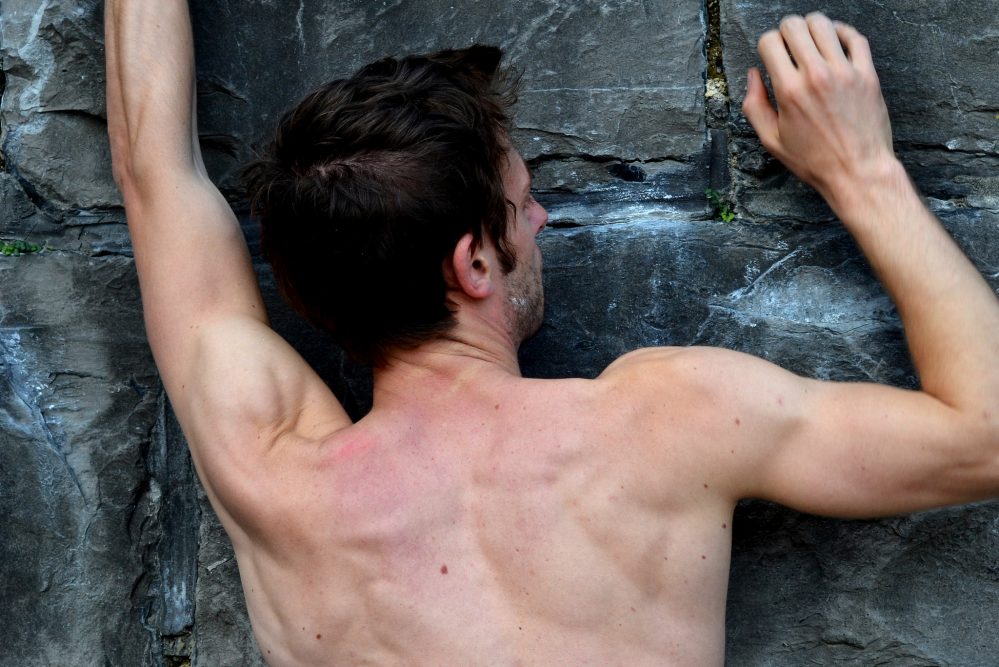Squeeze, stay tight, hold on!
We’ve all heard these supportive words from our climbing comrades before. Staying tight and squeezing our core and other muscles to stick a move has always been a tried and true method for sending. But similar to over-gripping on holds, we can sometimes squeeze and engage muscles that are not needed at the time, leading to those muscles getting pumped quicker than if we had selectively preserved the energy. Progressive Muscle Relaxation can help you learn to engage specific muscles that are needed at the time, while disengaging unneeded muscles.

Photo: Simon Blackley
Related: “Core Up!” — What it Means and How to Do It
Here’s how it works
Muscle memory is the process of your muscles remembering a sequence of movements and engagements. This happens with every person’s body, with any action. In climbing, the classic case is having a route or boulder problem so wired and dialed in that you can climb it on command. Muscle memory plays a large role in this because the more you repeat the sequence of moves, the more your muscles become acquainted with that specific movement, which makes it easier for them to engage in that movement overtime.
You can teach your body muscle memory, which is where Progressive Muscle Relaxation enters the picture.
Progressive Muscle Relaxation (PMR) is a technique for learning to monitor and control the state of muscular tension.
American physician, Edmund Jacobson, developed it in the early 1920s. How does this relate to climbing? Learning how to relax our muscles when we climb is just as valuable as learning to engage them properly.
PMR works through building the muscle memory of engaging muscles and then relaxing them. Through a specific methodology you focus on one muscle at a time, engaging and flexing it, and then releasing and relaxing it.
Related: 10 Tips to Climb Harder by Climbing Smart and Efficiently
Try this
The steps below outline a method for becoming more in tune with Progressive Muscle Relaxation. Try this technique and consider incorporating it into your warm-up routines to best apply PMR to your climbing:
To practice
- Lay flat on your back or sit straight up.
- Close your eyes and inhale deeply through your nose and out of your mouth 3 times. This will help center your focus on the activity.
- Start with your left foot. For 5 seconds, squeeze all of your toes and muscles in the foot. Then release the tension for 5 seconds. Pay attention to any and all feelings in the muscle while squeezing and releasing.
- Now do the same moving up your left leg. Go to your calf next, then your knee, to the thigh and end with squeezing your pelvic and left gluteus muscles.
- It is important to notice any other muscles that naturally try to engage themselves while you are focusing on a separate muscle. If this happens, try to only engage the muscle that you’re focused on. For instance, if you’re squeezing your foot and your calf engages, try your best to disengage your calf.
- Now switch sides and repeat the same sequence up your right side, starting with your right foot/toes, and ending with your right gluteus muscle. Squeeze for 5 seconds, release for 5.
- Move to your abdomen. Squeeze for 5 seconds, release for 5 seconds.
- Move to your right pectoral and lateral muscles. Then to your right shoulder, right bicep and tricep, and then your forearm.
- Make a fist and squeeze your right hand muscles.
- Now repeat steps 8-10 with your left side. Again, squeezing each muscle as hard as your can for 5 seconds and releasing for 5.
- Move to your neck and then to your face muscles.
- Squeeze your eyes shut for 5 and release.
- Now do this with your forehead.
- Then move down through your back muscles, squeezing and releasing.
- At this point you’ve moved through most of your body’s muscle groups, and you can end by squeezing every muscle at once for 5 seconds and then releasing.
- Inhale deeply and exhale fully 3 times.
Related: 3 Phases of an Effective Climbing Warm Up
When out climbing
Consider incorporating PMR practice into your warm-up routine. For example, on your first two climbs of the day, try pausing at every clip (or every 3-5 moves) to fully identify all engaged muscle groups. Ask yourself:
which muscles are unnecessarily engaged and can be relaxed?
Following these steps and repeating this method over time will help your body learn how to engage singular muscles, instead of forcing engagement on all of them at once. At times we want engagement in all of our muscles, while at others it helps to only engage the muscles we need for a specific movement so that we can save our energy by not using others. Like everything, the more you practice this old school technique, the greater the benefits will be. Soon you’ll be relaxed while clipping instead of hastily trying to get your rope into the quickdraw.
Further reading
- eBook — Modern Redpointing: Alternative Strategies to Improve Your Performance
- Mastering the Mind: An Interview with Mental Training Specialist, Paul Roberts
- How to Avoid and Manage Getting Pumped
- Visualization for Rock Climbing: What It Is and How to Use It
- 12 Tips to a Successful Bouldering Strategy







